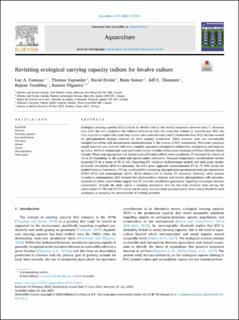| dc.description.abstract | Ecological carrying capacity (ECC) indices for bivalve culture rely on key ecosystem turnover rates: 1. clearance time (CT), the time needed for the cultured bivalves to filter the entire bay volume; 2. renewal time (RT), the time required to replace the entire bay volume with external water; and 3. production time (PT), the time needed for phytoplankton biomass renewal via local primary production. These turnover rates are conceptually straightforward but lack measurement standardizations in the context of ECC assessments. This study compares simple turnover rate methods with more complex approaches designed to address key assumptions and improve accuracy. Method comparisons were performed across multiple embayments (systems) in Prince Edward Island, Canada. When crop aggregation and system-scale refiltration effects were considered, CT increased by a factor of 14 to 22 depending on the system and species under cultivation. Seasonal temperature considerations further impacted CT by a factor of 38 to 142. Regarding RT, validated hydrodynamic models and tidal prism models produced remarkably different outcomes; the tidal prism approach underestimated RT by 77–94% across the studied systems. Conversely, PT was unaffected by contrasting phytoplankton parameterization; pre-aquaculture (1969–1970) and contemporary (2011−2012) datasets led to similar PT outcomes. However, other metrics revealed a contemporary shift towards low phytoplankton biomass and smaller phytoplankton cells (picophytoplankton); these observations suggest that PT provides insufficient granularity regarding microalgae biomass replacement. Overall, the study rejects a common assumption that the bay-scale turnover rates serving the conventional CT/RT and CT/PT indices can be easily and accurately parameterized; these indices should be used cautiously in assessing the sustainability of farming activities. | en_US |
